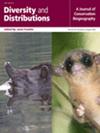Land Cover and Area Influence Bird Biodiversity in Geographically Isolated Wetlands
Abstract
Aim
Geographically isolated wetlands, wetlands surrounded by upland habitat, harbour high amounts of bird biodiversity but are rapidly being lost across the United States. Yet, we do not know which characteristics, such as wetland area or land cover, influence the level of bird biodiversity supported. We assessed the influence of wetland area and local (size of the wetland, 0.001–4.20 km2) and landscape (25 km) land cover on bird biodiversity in geographically isolated wetlands.
Location
Conterminous United States.
Methods
We quantified the impacts of the wetland area and different land cover on overall bird species richness and richness estimates within five functional groups. We integrated 207 geographically isolated wetlands, selected based on eBird sampling locations with over 100 total checklists. We computed land cover metrics within wetland sites and landscape buffers (25 km) around each site. Using a generalised linear modelling approach, we examined how species richness was impacted by area and six remotely sensed land cover variables.
Results
Species richness increased with area for all species and functional groups of birds, but aquatic (e.g., ducks) and terrestrial (e.g., wading birds) functional groups had the steepest species–area slopes. Constructed wetlands exhibited a steeper species–area relationship slope compared to natural wetlands. Species richness was negatively correlated with built land cover at the local and landscape scales and was positively associated with flooded vegetation at the local scale and grass cover at the local and landscape scales. All functional group richness estimates responded negatively to build land cover but showed unique responses in their associations with other land cover variables.
Main Conclusions
Anthropogenic disturbance at the local and landscape scales significantly reduces species richness. Land managers looking to create or restore wetlands, which have steeper species–area curves, should consider local-scale management changes in flooded vegetation or grass cover to improve habitat for birds.


 求助内容:
求助内容: 应助结果提醒方式:
应助结果提醒方式:


